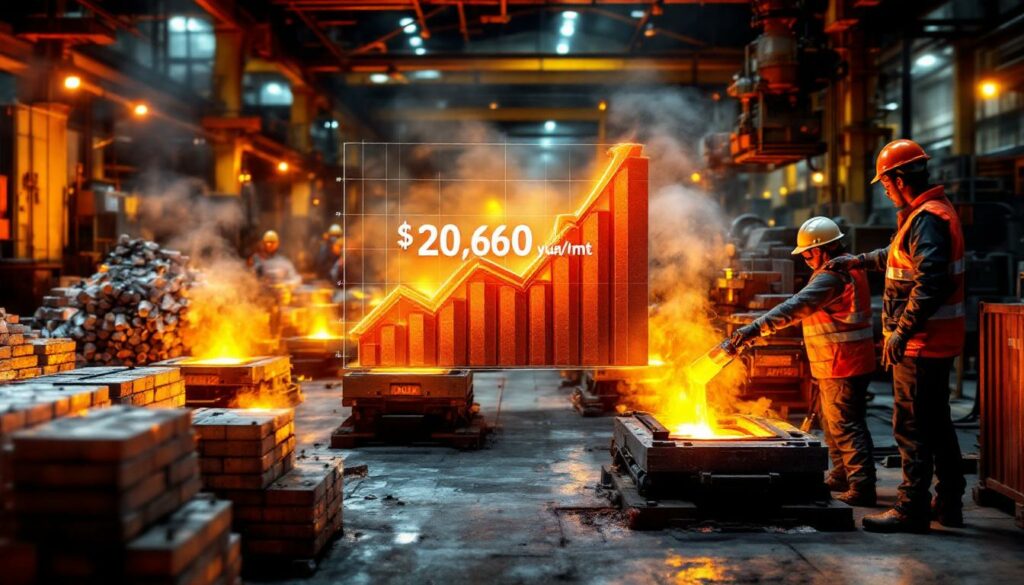Cast Aluminum Alloy Market: Navigating Supply Challenges Amid Shifting Demand
The cast aluminum alloy market finds itself at a critical junction where strong cost support and weakening demand create a complex operating environment. This tension is reshaping industry dynamics as manufacturers struggle with raw material procurement challenges while facing pressure to maintain operational efficiency.
Key Market Indicators Reveal Mixed Signals
Recent data from Shanghai Metal Market (SMM) shows the A00 aluminum price increased by 60 yuan/mt to reach 20,660 yuan/mt, while the SMM ADC12 price held steady at 20,000 yuan/mt. These price movements reflect the underlying market forces at play.
In the futures market, the most-traded AD2511 cast aluminum alloy contract closed at 19,945 yuan/mt, marking a 115 yuan/mt (0.58%) increase. Trading volume stood at 1,930 lots with open interest at 8,658 lots, indicating active market participation despite challenging conditions.
The theoretical premium of SMM ADC12 spot price over futures has narrowed to 130 yuan/mt, suggesting a potential convergence between immediate and forward-looking market expectations.
"The strong cost support and weak demand continue to engage in a tug-of-war, creating a delicate balance that could tip in either direction depending on how supply chain pressures evolve," notes industry analysts at SMM.
Why Are Raw Material Shortages Impacting the Industry?
Aluminum Scrap Supply Constraints Intensify
The cast aluminum alloy sector is experiencing unprecedented pressure from tightening aluminum scrap supplies. This shortage spans both domestic and international markets, creating a perfect storm of procurement challenges that ripple throughout the production chain.
Secondary aluminum producers report significant difficulties securing adequate raw materials, forcing many to compete aggressively for limited supplies. This "material scrambling" has intensified competition and driven up production costs, ultimately expanding corporate losses across the industry.
Regional Supply Dynamics Show Geographic Disparities
The impact of scrap shortages varies significantly by region:
- Baled UBC (used beverage can) prices rebounded by 50 yuan/mt, following broader aluminum price trends
- Shanghai, Jiangsu, and Shandong regions experienced price adjustments ranging from 50-100 yuan/mt
- Guizhou and Hunan maintained stable pricing despite market pressure
- Jiangxi remained steady after previous adjustments to "digest sentiment"
- Shredded aluminum tense scrap prices have shown remarkable resilience due to "extremely tight supply"
The geographic variation in price adjustments reveals how local market conditions, transportation infrastructure, and industrial concentration influence regional scrap economics. Furthermore, recent aluminium scrap assessments indicate that this trend is likely to continue across global markets.
Quality and Grade Variations Compound Challenges
Beyond simple availability, manufacturers report increasing difficulty finding consistent quality in scrap materials. This variability in aluminum scrap grades creates additional production challenges as facilities must adjust processing parameters to accommodate inconsistent input materials.
How Are Production Cuts Affecting Market Dynamics?
Manufacturers Implement Strategic Output Reductions
Facing the dual constraints of raw material shortages and softening demand, secondary aluminum manufacturers have been forced to make difficult operational decisions. Many facilities have implemented strategic production cuts to manage costs, while some have entered complete shutdown states.
These production adjustments represent attempts to balance financial sustainability with market presence as manufacturers navigate uncertain conditions.
Inventory Trends Signal Demand Weakness
Social inventory of secondary aluminum alloy ingots in key markets (Foshan, Ningbo, and Wuxi) reached 24,546 mt as of early July, showing concerning growth patterns:
- Daily increase: 299 mt
- Weekly increase: 3,267 mt
This accelerating inventory buildup signals potential demand weakness in downstream sectors, creating additional pressure on producers already struggling with input costs.
"The current inventory trajectory suggests a potential disconnect between production output and end-market consumption, which could further pressure pricing if not balanced by corresponding production discipline," according to market analysts.
Production Economics Under Pressure
The financial equation for secondary aluminum production has deteriorated significantly. Rising scrap costs have not been fully offset by finished product price increases, squeezing margins throughout the value chain. This margin compression has forced difficult operational decisions, with many producers choosing to idle capacity rather than operate at a loss.
What's Happening in the Futures and International Markets?
Cast Aluminum Alloy Futures Show Growing Market Maturity
The cast aluminum alloy futures market has demonstrated impressive development as a risk management tool for industry participants. Over 22 consecutive trading days, cumulative trading volume reached 205,700 lots, with open interest standing at 10,200 lots – equivalent to approximately 102,000 mt of spot cargo.
This market scale represents roughly 27% of domestic monthly consumption, indicating growing adoption of financial instruments for hedging and price discovery in the aluminum alloy sector. Investors looking for diversification might consider reviewing an ETC investment guide for alternative exposure to the metals market.
International Trade Economics Remain Challenging
The international market presents additional complexities:
- CIF import price of ADC12 remains stable at $2,450-2,480 per mt
- Import spot price hovers around 19,200 yuan/mt
- Import losses have widened to approximately 900 yuan/mt due to RMB depreciation
- Thailand's tax-excluded ADC12 quotes concentrate at 82-83 Thai baht/kg
The widening import losses highlight how currency fluctuations can significantly impact trade economics, creating additional barriers to international material flows despite global supply imbalances.
Currency Effects Amplify Trade Challenges
RMB depreciation has significantly widened import losses to approximately 900 yuan/mt, creating additional barriers to international material flows. This currency effect has essentially created a financial wall that prevents imports from filling domestic supply gaps, further tightening the local market.
What Regulatory Developments Are Affecting the Industry?
Futures Market Cultivation Continues
The Shanghai Futures Exchange (SHFE) continues to intensify market cultivation efforts for cast aluminum alloy contracts. These initiatives include ongoing market promotion, training activities, and preparations for the first physical delivery of cast aluminum alloy futures.
SHFE is actively monitoring market operations and gathering feedback to optimize trading rules, enhancing the utility of these financial instruments for industry participants.
Payment Compliance Reporting System Launched
In a significant development for supplier relationships, the Ministry of Industry and Information Technology has launched an "Online Window for Reporting Issues Related to Key Automakers' Payment Cycle Commitments." This system enables small and medium-sized enterprises to report non-compliance with payment commitments.
This regulatory development addresses payment delays to secondary aluminum suppliers, potentially improving cash flow predictability throughout the supply chain. Automotive manufacturers represent a significant end-market for cast aluminum alloys, making payment terms a critical consideration for industry participants.
Environmental Regulations Impact Recycling Economics
While not explicitly detailed in recent market reports, ongoing environmental regulations continue to influence scrap collection, processing, and international trade. These regulatory frameworks shape the economics of aluminum recycling and contribute to the current supply constraints affecting secondary producers. In this context, critical minerals recycling initiatives are becoming increasingly important for long-term industry sustainability.
What's the Outlook for Cast Aluminum Alloy Prices?
Short-term Price Projections Remain Cautious
Market analysts anticipate ADC12 prices will maintain a rangebound pattern with weak bias throughout July. This outlook reflects the ongoing tension between strong cost support (driven by scrap shortages) and weak demand suppression (evidenced by rising inventories).
The aluminum scrap market is expected to hover at elevated levels with cautious price adjustments as suppliers balance inventory management with cash flow requirements. According to a recent report by Metal.com, these market conditions are likely to persist through the third quarter.
"The continued tug-of-war between strong cost support and weak demand suppression will likely keep prices rangebound in the near term, with a slight downward bias as demand concerns outweigh supply constraints," according to industry forecasts.
Import Economics Remain Challenged
International supply dynamics are unlikely to provide significant relief in the near term. Import losses remain challenging due to currency fluctuations, effectively maintaining barriers between domestic and international markets despite price differentials.
Long-term Supply-Demand Balance Requires Structural Solutions
Beyond immediate pricing concerns, the industry faces longer-term questions about sustainable supply-demand balance. Structural improvements in scrap collection efficiency, development of alternative input materials, and optimization of production technologies will be necessary to address persistent raw material challenges. These developments align with broader industry evolution trends that are reshaping the metals sector globally.
FAQ: Cast Aluminum Alloy Market
What factors are driving the current tightness in aluminum scrap supply?
The tightness in aluminum scrap supply stems from multiple factors including reduced collection efficiency, logistical constraints, and increased competition for recycled materials across various industries. This supply constraint affects both domestic and international markets, creating significant procurement challenges for secondary aluminum producers.
Regional variations in scrap availability highlight how local factors such as transportation infrastructure, industrial concentration, and collection systems impact material flows. The "extremely tight supply" of shredded aluminum scrap particularly demonstrates how specific grades can experience disproportionate supply constraints.
How do futures contracts help aluminum industry participants?
Futures contracts provide essential risk management tools for aluminum industry participants by offering price discovery, hedging opportunities, and forward pricing mechanisms. The growing adoption of cast aluminum alloy futures, now representing approximately 27% of domestic monthly consumption, demonstrates their increasing importance in managing market volatility.
These financial instruments allow producers to lock in future prices, helping to mitigate risks associated with raw material cost fluctuations. Similarly, consumers can use futures to secure predictable input costs, supporting more stable business planning despite market uncertainty.
The options market provides additional flexibility by enabling participants to manage price risks with more sophisticated strategies while limiting downside exposure.
What strategies are secondary aluminum manufacturers using to cope with current market conditions?
Secondary aluminum manufacturers are implementing various strategies to navigate current market challenges:
- Production cuts to align output with realistic sales projections
- Operational shutdowns to avoid loss-making production
- Raw material sourcing diversification to reduce dependency on specific suppliers
- Inventory management optimization to balance working capital requirements
- Strategic customer prioritization based on relationship value and payment terms
- Process efficiency improvements to minimize material loss and energy consumption
These adaptive responses represent attempts to maintain financial sustainability while preserving market position during challenging conditions. Many companies are also exploring investment opportunities 2025 to strengthen their market position despite current headwinds.
How do regional differences affect aluminum scrap pricing?
Regional differences in aluminum scrap pricing reflect local supply-demand dynamics, transportation costs, collection infrastructure, and industrial concentration. Areas like Shanghai, Jiangsu, and Shandong show more responsive price adjustments (50-100 yuan/mt), while regions like Guizhou and Hunan demonstrate more stable pricing patterns.
These geographic disparities create opportunities for regional arbitrage but also present challenges for nationwide operations seeking consistent input costs. Understanding these regional variations is essential for effective procurement strategies, especially during periods of market stress.
Transportation infrastructure plays a particularly significant role in regional pricing, as logistical constraints can effectively isolate certain areas from broader market pressures or prevent efficient material flows between surplus and deficit regions. According to Shanghai Metal News, these regional disparities are expected to persist throughout 2025.
Further Resources for Cast Aluminum Alloy Market Participants
Industry participants seeking additional market intelligence can access specialized reports and analysis through organizations like Shanghai Metal Market (SMM), which provides in-depth coverage of metals markets including cast aluminum alloys.
The Shanghai Futures Exchange (SHFE) offers resources for understanding and utilizing futures and options contracts for risk management, including training materials for new market participants.
Disclaimer: This market analysis is based on information available as of July 2025 and represents current market conditions. Future developments may differ significantly from projections. Financial decisions should incorporate comprehensive research and professional advice relevant to specific circumstances.
Ready to Stay Ahead of Major Mineral Discoveries?
Discover why significant mineral findings can lead to exceptional market returns by exploring Discovery Alert's dedicated discoveries page, where our proprietary Discovery IQ model provides real-time alerts on promising ASX announcements, giving you a crucial market advantage before the broader investment community catches on.




